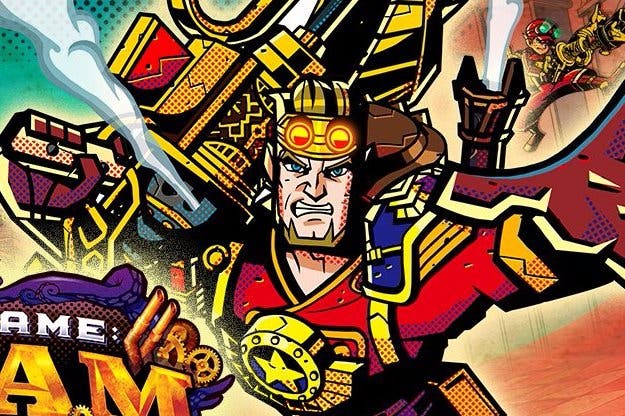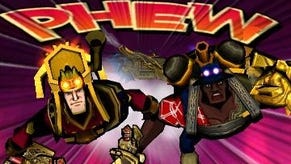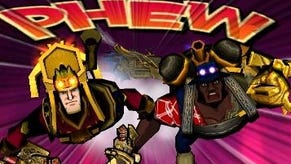Code Name: STEAM review
America the shootiful.
Given its antic plundering of creaky old books, it should not be surprising that Code Name: STEAM finds its soul in a library. And not just any library. This is the great library at Miskatonic University, the starting point for so many excursions into the weird, the deathless, the unthinkable. More on that stuff in a bit. What's important is that the library is a wonderfully unusual map, and one that brings out the best in a wonderfully unusual - and often infuriating - game. Code Name: STEAM is a squad-based tactics affair (more Valkyria Chronicles than XCOM due to the granularity of its action points variant) and the library level starts by encouraging you to split your team of four into two teams of two. You're on the back foot from the end of the first turn.
The mission here seems pretty simple: simultaneously activate two switches at opposite ends of the map, and then beat it downstairs to the huge metal gate that the switches have opened for you - a gate that houses your goal and a couple of real beasts called Berzerkers who are standing in front of it. As is often the case with this sort of game, things got good for me only when things got bad. One of my teams ran into serious trouble - sniper and grenade aliens waiting just beyond the first of the switches, taking out Henry Fleming, of the Red Badge of Courage, and all but crippling the Scarecrow (who only wanted a brain). The gate was open, the last save point was used up and these guys were a mess - so getting to the goal depended on the other team.
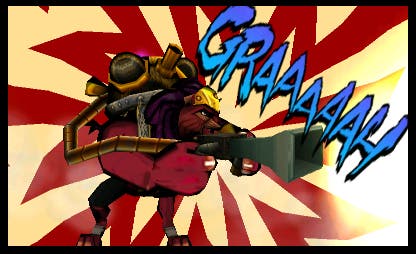
There were dozens of ways that things could play out. I should know: I tried most of them. Code Name: STEAM is a weird, rather ornery game, with its claustrophobic levels, its endless enemy reinforcements, and the fact that, in a direct contradiction to the approaches of most strategy titles, you're not given any kind of overhead view of the terrain. Other strategy games might ration ammo or special moves: in Code Name: STEAM, information is the most valuable resource, and it's also the hardest to come by. Some people find this insanely annoying as they hunt, endlessly, for a map screen that simply isn't there, or wait out enemy turns staring at the back of a pillar. I genuinely understand their pain. But in the library, that lack of intel came together with tight spaces, tricksy vertical pathways and a range of strongly-defined characters to create the very thing that all strategy games aspire to being: a laboratory of tactics, a place where you muddle about with your inputs until you achieve the output you're after - or something even better.
Lion (formerly cowardly) is good with leaping, for example. He was low on health, but could I hop him across the teetering spars of bookstacks to get him within kicking distance of the goal, bypassing the Berzerkers entirely? Short answer: no, but it was fun trying. Let's try something else. Tom Sawyer can lay down landmines (never quote what I've just written in English class). Could I use them to whittle away the grenade guys, so he could reach the goal safely? Short answer: still no. They'd just fire over the landmines, and then Tom's dead too.
But wait. Could Tom use the landmines on the Berzerkers, and then Lion might be able to make that desperate hop to safety? I'll be honest, I didn't think this would work, and the first three times I tried it, it didn't. Luckily, I had Scarecrow - nearly dead, of course - waiting in the wings. I thought he was too far from the battle to be any help, but the distance was mainly vertical, and I had neglected a tiny gap in the scenery he could launch a health boost through. Lion connected with that like a quarterback running full tilt to the endzone. The defence were kept in place by Tom Sawyer, and together we won the day. A half hour map had taken me an hour and 15 minutes, but who cares? Who cares?
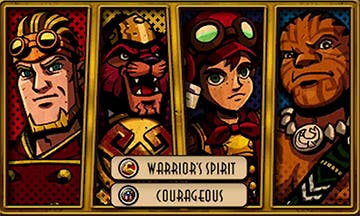
Code Name: STEAM is not quite so thrilling from the off, alas. If you were a terrible person, you might say that it takes a while to get to the boil. Hopefully, you would then sit on a fork. No matter: the library at Miskatonic comes many hours into the adventure, after a slow opening may have ground some of your initial enthusiasm to dust.
This is a simple game on paper, but it has a tutorial that never quite trusts you enough to let you discover that for yourself. Damningly for a game that really shines when you're leading a squad of four, it takes a bit too long to allow you to build up your ranks to the point where each mission begins with the agonising choice of who to leave behind. It also spends a bit too long at the start futzing over the story - in the great age of Steam, the earth is invaded by icy aliens intent on taking control - and then it fumbles what should be an easy introduction to the core rules, namely clueing you into the fact that you control a group of soldiers whose movement and weaponry are both powered by the boilers they carry on their backs. Racing around the map and blowing baddies away will always be a trade-off, in other words. Since each character comes with both a primary weapon and a secondary which will carry different steam costs, along with their own boiler type which dictates how much energy they have to play with in the first place (and how much of it recharges between turns), you can lose a tactical battle through a strategic choice that you made back at the equipment-choosing stage in the safety of Lady Liberty. That's an airship hub owned by - who else? - Abraham Lincoln.
Get your head around that, and there are a couple of other things to take into account. While there's a grid laid out on the landscape, the levels you race through are elaborate and often confusing spaces, and - this bears repeating - you're entirely limited to the viewpoints of each of your four soldiers. It seems strange at first, but it's actually part of the fun, since you learn to anticipate danger that you might not be able to see as you gain a better understanding of the alien types you face and the way they like to trap you. Alien types are something of a strength, incidentally, including those that fire from a distance, those that sweep in close and slash away with talons, and even some - my favourite - that are actually blind and roll end-over-end, often running into each other as they zero in on promising noises. Blind enemies who might accidentally thin their own ranks! Swoon!
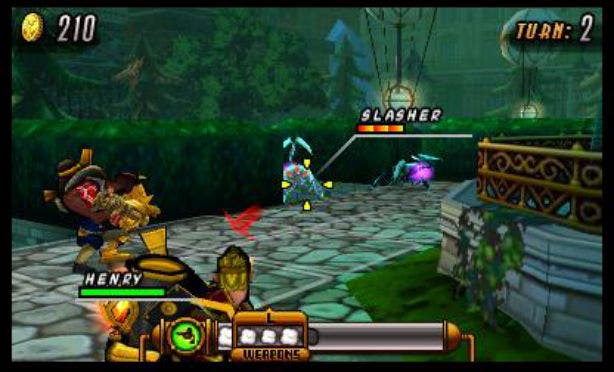
The absence of a map's also an indicator that you'll need to divide in order to conquer. You can play it safe and edge through each level as a team of four, but it's much wiser and more empowering to hop a guy up onto a ledge early on, so that they can act as a spotter for the rest of you. This is particularly important since Code Name: STEAM doesn't want you to dally. Although there are a few exceptions that crop up towards the end of the adventure, you generally don't have to kill everyone on a level. Instead, you just have to make it to the goal line. To reinforce this point, the game chucks in, well, reinforcements, spawning every so often to further underline the importance of forward momentum and punish undue caution.
In truth, even when you know what you're doing, Code Name: STEAM can often seem infuriating in its early hours. Enemies' overwatch attacks will stall you unexpectedly when you're trying to make a heroic run over open ground, while early levels drop in buzzing gnat type foes who are hard to hit and also stun you, eating up a turn and leaving precious steam in the tank. Equally, chucking in reinforcements pushes you forward, but it also raises the chances of a match deteriorating into stalemate.
You're being schooled, of course, since victory generally hinges on a kind of careful swfitness rather than a chaotic headlong rush, and you're also being taught that, unlike so many turn-based games, your actual aim is as important as the stats your weapon brings with it here. You can miss from close-up if you neglect to factor in an alien's breathing, or its bobbing in the air that shifts its body around. Even so, it's still strange to see a game made by Intelligent Systems that seems not to care about the many things it does that could be annoying to its players. Throw in lengthy enemy turn times - shortened by a recent update but still longer than you might expect - and you have a game that's going to hemorrhage some of its audience fairly early on.

And this is a tragedy, because when enemies and powers converge, it is a hell of a game. In Washington D.C., for example, fighting through a train yard on a long, wide map with a goal at the far end, it is Lovecraftian American Football. Heavies like John Henry run defence, Randolph Carter distracts the big foes with his Unspeakable Lure (a throwable lump of frozen meat - don't ask what kind - that draws aggro), and the small, nimble Tom Sawyer dashes to the endzone unbothered. At other times, it's bar billiards, as you employ cheap shots for their knockback effects on enemies, just to get their glowing weak spots in position for your sniper. There is complexity here, and it is both manageable and capable of turning the tide of a battle. It is complexity that generates creativity. Crucially, it frequently forces you to bring all of your squadmates together in the service of one glorious plan. Stunning a foe, for example, stops them from retaliating, but also lowers their defence for the next attack from somebody else: voila, you're suddenly thinking in terms of chains, combos.
A boss fight early on gives you a glimpse of all of Code Name: STEAM's better ideas working in symphony, as you move between patches of overhead cover en route to a mortar that flings death from above. Everything clicks when you realise the aliens you face aren't trying to kill you with their shots so much as push you out into open ground where the big gun can do its work. It feels like I was solving this particular map rather than merely completing it, and the key to my success turned out to be my own overwatch abilities. Happily, I've since played it again with a different squad and solved it in an entirely different manner, too. It felt like a different map.
There's more variety across the campaign's 16 chapters than you might expect, then, and that's before you take into account weird palette cleansers like sequences in which Honest Abe, the leader of your team of patriotic misfits, climbs into a giant stovepiped mech to battle a gnarly alien beachball the size of the White House. As the presence of Abe himself might indicate, if you love Americana, Code Name: STEAM takes on a whole new level of beauty, too. There's a real nerdish delight to be had as your team fills up with people like Queequeg from Moby-Dick, and Queen freakin' Califia. To mash her world alongside the worlds of Melville and Twain and L. Frank Baum and Lovecraft, literature's busiest dead racist, is a kind of backwoods genius. Code Name: STEAM almost deserves a Cliff Notes.
It's true that the script is clumsy and often badly acted - although Michael Dorn wrings unlikely poetry from the phrase, "They musta heard me clankin' around!" - and yet Code Name: STEAM's characterisations shine where it truly counts. Not in the lines of dialogue or the contortions of the plot (contortions, it must be said, that allow for a surprising wealth of different map types, and build to a Wonderful twist at the end of act two where I felt like standing up and applauding), but in the way that each classic figure from history or literature or myth is reimagined as a weapon set and an accompanying special power. Queequeg, to use a favourite example, fires robotic penguins that waddle along the ground in a straight line before exploding when they hit something. His special - like all specials, invoked by yanking the kind of hanging chain that would traditionally stop a speeding locomotive - is a harpoon that pierces multiple targets, and even allows for a fleeting cameo from the white whale himself. You can only trigger that once a map; I never forget to do so.
The others tend to be just as good, whether it's Tom Sawyer's boxing glove on the end of a spring, which seems useless until you realise just how many times he can fire it during a turn, or John Henry's super-powered hammer attack, a guilty pleasure whenever it is unleashed, more than making up for a mortar that simply doesn't work in confined spaces. Clever references are one thing, but all of these characters change the way you can approach things. They have the potential to rework the game entirely each time you play.
All of this, of course, is wrapped up in art that you will either love or hate: spiky, chunky disco patriots striking poses across a four-colour world that's been liberally sprayed with inky-fingered half-tone. It seems like an odd departure given the quiet die-cast dignity of Advance Wars, but, seriously, who else could do justice to the story of American Gods dropped into the world of Cthulhu other than Jack Kirby?
Perhaps the divisive art gets to the crux of the whole game, in fact. Schooled on the polite precision of Advance Wars and Fire Emblem, it's easy to be slightly offended by the realisation that Code Name: STEAM isn't yet another microsurgical piece of strategy design with not a single tiny piece out of place. For my money, that's actually what's great about it. This is a rare chance to see a perfectionist developer working well beyond its comfort zone. It's scrappy and risky and obdurate and wild - and occasionally even ugly and muddle-headed. But when it soars? It soars like an eagle.
